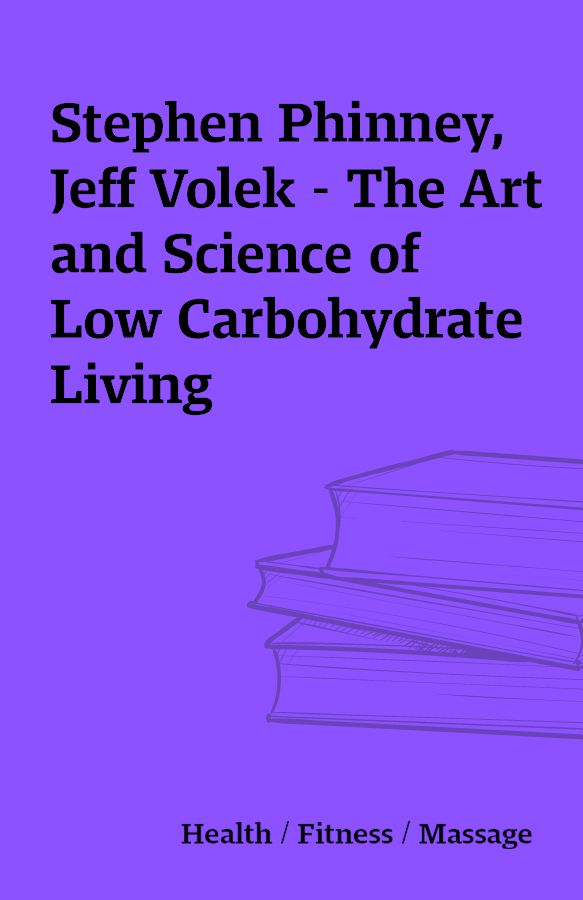Stephen Phinney, Jeff Volek – The Art and Science of Low Carbohydrate Living
Stephen Phinney, Jeff Volek – The Art and Science of Low Carbohydrate Living
[1 eBook – 1 MOBI]
Description
The Art and Science of Low Carbohydrate Living by Jeff S. Volek, Stephen D. Phinney The Art And Science Of Low Carbohydrate Living: An Expert Guide To Making The Life-Saving Benefits Of Carbohydrate Restriction Sustainable And Enjoyable.Carbohydrate restricted diets are commonly practiced but seldom taught. As a result, doctors, dietitians, nutritionists, and nurses may have strong opinions about low carbohydrate dieting, but in many if not most cases, these views are not grounded in science.Now, whether you are a curious healthcare professional or just a connoisseur of diet information, two New York Times best-selling authors provide you with the definitive resource for low carbohydrate living.Doctors Volek and Phinney share over 50 years of clinical experience using low carbohydrate diets, and together they have published more than 200 research papers and chapters on the topic. Particularly in the last decade, much has been learned about the risks associated with insulin resistance (including but not limited to metabolic syndrome, hypertension, and type-2 diabetes), and how this condition is far better controlled by carbohydrate restriction than with drugs.In this book, you will learn why:Carbohydrate restriction is the proverbial ‘silver bullet’ for managing insulin resistance, metabolic syndrome and type-2 diabetes.Restricting carbohydrate improves blood glucose and lipids while reducing inflammation, all without drugs.Dietary saturated fat is not a demon when you are low carb adapted.Dietary sugars and refined starches are not needed to feed your brain or fuel exercise.Long-term success involves much more than simply cutting out carbs.Electrolyte and mineral management are key to avoiding side effects and ensuring success.Trading up from sugars and starches to a cornucopia of nutrient-rich, satisfying, and healthy foods is empowering.Studying hunter-gathers’ diets provides clues to how best formulate a low carbohydrate diet.This is a great book for health-minded individuals.It is an excellent book for healthcare professionals.Best of all, it is the perfect gift for health-minded individuals to share with their doctors, dietitians, and nutritionists.About the AuthorsJeff Volek is a dietitian-scientist who has spent 15 years studying diet and exercise effects on health and performance. He has held an academic position at Ball State University and is currently an associate professor at the University of Connecticut. Dr. Volek has contributed to 3 books, 2 patents, and over 200 papers. He received his dietetic training at Michigan State University and Penrose St Francis Hospital and his PhD in Exercise Physiology from Penn State University.Steve Phinney is a physician-scientist who has spent 35 years studying diet, exercise, fatty acids, and inflammation. He has held academic positions at the Universities of Vermont, Minnesota, and California at Davis, as well as leadership positions at Monsanto, Galileo Laboratories, and Efficas. Dr. Phinney has published over 70 papers and several patents. He received his MD from Stanford University, his PhD in Nutritional Biochemistry from MIT, and post-doctoral training at the University of Vermont and Harvard. File Size: 578 KBPrint Length: 275 pagesPublisher: Beyond Obesity LLC (July 8, 2011)Customer Reviews:Clear, Unabridged, Hard-Hitting Nutrition ScienceBy Shelley D. Schlender on May 28, 2011Format: Paperback150 of 156 people found this review helpfulThis is a rigorous, detailed, technical, practical, and at the same time, often surprisingly witty book. The chapter on paleolithic diets persuasively argues that fat was a bigger part of them than most anthropologists realize. The section on how saturated fats track with overall health is intriguing, and the theories and observations provided about how low carb, high fat diets reduce inflammation and the stress of free radicals and oxidation is fascinating. So is the explanation for why someone on a low-carb diet may want to increase their intake of sodium and magnesium. Note that this book WILL be controversial. As the authors write, “If you want clear, unabridged, and hard-hitting nutrition science, buy this book. If you want the mainstream consensus view, put it down gently and tip-toe quietly away.Real Science Doesn’t LieBy David Dreyfuss on June 3, 2011(Full disclosure: one of the authors [Stephen Phinney] gave my wife and I a copy of this book at a dinner meeting prior to a presentation by Dr. Phinney at Zombie Runners in Palo Alto, CA. It was, however, our first meeting.)The Art and Science of Low Carbohydrate Living is a self-published follow-on book intended to provide more solid scientific backup for the more practical advice given in the authors’ recently published The New Atkins for a New You (which was further coauthored by Eric Westman). They elected to self-publish when they found that publishers they approached did not want them to include as much real science content as they wished to write. They did not want to write for an eighth-grade level, but rather wanted to write a book that would be of real value to both scientists and clinicians while still being accessible to more general audiences who might not catch all of the subtleties. On balance, I believe that this was the right decision in that I approve wholeheartedly with the sort of detail that they chose to include. At the same time, the editor in me finds that the book would have benefited from a little polishing by a real editor–just to fix minor issues of punctuation, style, and layout that don’t really detract from the content, but which are there all the same. That said, I found the book a compelling and easy read.I’ve been a low-carb lifestyle convert for a few years now myself, and I’m fairly well-read both with respect to popular literature on the subject and the scientific literature. As such, I was very familiar with much, but certainly not all, of the subject matter. What I find particularly interesting in this book is that it represents at least the beginnings of a transition from early literature that has, of necessity, focused on a sort of sales pitch for the merits and benefits of low-carb nutrition to a slightly more mature phase where there is more emphasis on studying and analyzing the hows and whys. The authors have been studying low-carb nutrition in the lab for decades now, and they clearly don’t think there’s any question about whether low-carb nutrition is safe and effective anymore (nor do I). They do, however, recognize and devote some significant discussion to the ongoing lack of acceptance by “mainstream” political and professional institutions despite the now overwhelming scientific evidence. The slow progress continues to be a serious indictment of our current peer review, public policy making, and quality control processes for scientific research. The current status quo is such that many readers will still consider a lot of the positions taken by the authors to be downright heretical or at least controversial, but the authors (and I) are confident that it is now only a matter of time (if still a few more years) until their ideas and analyses finally become mainstream and displace recommendations that simply have not withstood the test of time and experiment.The real meat (pun intended) of the book is in Sections 3 and 4 covering physiology and clinical applications as we now understand them. There is a clear bias toward reporting results of the authors’ own experiments–not necessarily a bad thing in that they have personally done a lot of important work in the field. The human body is a remarkable machine with complexities that we are only just beginning to unravel, and any fair review (such as this book) leaves one with more unresolved questions than definite answers, but it is clear that we already know a lot more than most critics are willing to admit. There has been real and steady progress in recent years in developing a better understanding of the important nutritional and biochemical pathways, and the next few years should continue to be exciting as we learn more.Key to both scientific understanding and clinical practice is finding the right “bio-markers” to measure and study. There are some serious flaws in how most standard clinical labs measure and use certain quantities today. The authors discuss some up-and-coming developments that will be of particular value in better monitoring quantities relevant to the effects of carbohydrate sensitivity and carbohydrate restriction. They also make it clear that we should no longer be trying to use a one-diet-fits-all model of human dietary recommendations. And they state quite emphatically that carbohydrate restriction is not for everyone, just that there are very large populations for whom it is a much better choice. Humans are omnivores and are capable of adapting to some extent to a wide variety of food choices. We are, however, learning that a sizable majority appear to thrive better (with fewer undesirable side effects) with very little (or at least much less) carbohydrate in their normal diet.The major interest in low-carb diets in recent years has come primarily from their effectiveness for weight loss, though there are important benefits for other applications as well. Low-carb diets are very effective for treating (or preventing) metabolic syndrome (it worked for me!), diabetes, seizures and other neurological conditions, heart disease, and probably a host of specific cancers and other so-called “diseases of civilization.” There is also growing interest in the value of low-carb nutrition for athletic performance (also works for me!). These are touched on in varying detail in this book, though the book would have needed to be three times as long to really do justice to every application. This book emphasizes weight loss, metabolic syndrome, and type II diabetes, together with a guest chapter on treatment of seizures; it would have been nice to have a similar guest chapter on heart disease which is also of great importance right now–perhaps in the next edition. I have every hope and expectation that this book will be obsolete in a few years, but in the meantime, I highly recommend it as a way to bring yourself up to date on the current state of knowledge about carbohydrates in human nutrition.n Depth and Utterly FascinatingBy CMCM on July 12, 2011Format: Paperback Verified Purchase 400 of 405 people found this review helpfulThere are so very many in depth and all inclusive reviews I see no reason to parrot what they have all said, but I’ll say that I agree enthusiastically. Jimmy Moore’s review in particular is a gem!As a person who is fascinated with this subject and who eagerly devoured both of Gary Taubes’ books, this one offers yet a deeper and more clinical examination of the science of low carbohydrate eating from two doctors who have been immersed in this field for 30 years. This is most definitely NOT a book for the casual reader interested in following a low carb diet. Rather, this is a book that will be understood and appreciated by someone who has a great deal of personal interest in learning more about this subject and who enjoys the deeply scientific explanations and discussion, and additionally, a person who has already done a fair bit of reading on this subject. This book is most definitely targeted at someone with a scientific and medical background, specifically doctors, and there are things that I had to read a few times to fully comprehend and absorb, but if you have the inclination and interest, this is a very rewarding and enlightening discussion that is quite unique in the current low carb literature. One would be hard pressed to deny the absolutely overwhelming and glaring evidence arguing for low carb diets when the vast body of proof is presented as compellingly and clearly is it is here. Low carb’s undeniable superiority as a way of eating is nothing short of amazing to read about in all its historic and fascinating glory. My own personal observation and experience (also success) with eating low carb left me with vaguely formed ideas and I was self-identified as perhaps a “carb sensitive” person, and yet I couldn’t put it all together in terms of how it ultimately affected me until I read this book, which discusses this subject at great length. Carb sensitivity is apparently a matter of degree within each individual, and I now understand the hows and whys of its effects on me as related to my own independent observations over the years. It’s now clear why a low carb diet works so superbly and easily for me (when nothing else works) and why it has so vastly improved my health in myriad ways.Another important discussion was that of individual variability, which explains why not every diet works for everyone equally, why some don’t gain weight on a high carb diet and why some can lose weight equally well on various types of diets. One shoe obviously does not fit all, and for some, only one shoe fits!Despite my own success with weight loss and good health eating low carb, I still had this nagging worry about fats in particular, especially in light of the deafening chorus of low carb detractors out there who railed endlessly about the dangers of fat. My insecurity about this aspect of low carb eating has now been entirely put to rest because of how fully the authors explain the body’s use of fat in all its aspects. This alone make this book a valuable asset.As it was when I was reading the two Taubes books, I continue to be dismayed and disgusted by the narrow mindedness and yes, dishonesty of the general scientific/nutrition community. The word “sheeple” comes to mind, but it’s even more than that. It’s about politics, money, influence peddling as well. It is nothing short of amazing how so many of us lay folks out in the trenches can quite clearly see all the evidence for what it is and relate it to our own experiences, and as a result we draw such a different conclusion from the so-called “experts” with regard to the merits of low carb eating. Many, maybe even most of the diet gurus continue to march down that same old highway chanting their tired mantra of low fat/high carb/grains are great, all while totally ignoring or at least remaining oblivious to decades of increasing obesity rates that are the result of their recommendations. Do they never connect any dots or examine the evidence? In the popular media, it is a continual frustration to hear them continue to hawk diets full of the very foods that keep their patients overweight, increasingly diabetic and unhealthy. Virtually everything I come across that is not written within the low carb framework is jam packed with misinformation and downright untruths, proclaiming as desirable, healthy and effective the very approaches and strategies that were long ago shown to be just the opposite. Old habits and beliefs die hard, apparently.So if you have already done a fair bit of reading on this subject and thirst for a deeper, more thorough knowledge and understanding of the history and actual body mechanics of low carb nutrition, then this is definitely a book you will want to read and enjoy. In addition, it provides you with a huge new database of ammunition with which to make your own case and defense of low carb nutrition! Overall a very fascinating, enlightening, comprehensive and well presented discussion that delves deeper than anything I have yet to come across in this field. Despite the rather high cost of this book, it is well worth owning.My own purchaseadishonerv69
You must be logged in to post a review.






Reviews
There are no reviews yet.